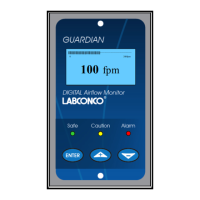2.2 Calibration :-
1. Power up the unit and wait at least 30 secs while the sensor temperature stabilises.
2. If the unit has not been calibrated the unit will display ‘ Requires setup ’ – press ENTER
to continue and in the Main Menu use the +/- buttons on the alarm facia select ‘ SETUP ‘
and then press the ENTER button.
3. In the Setup Menu select ‘CALIBRATION’ and press the ENTER button
4. At this stage you will be requested to enter the PASSWORD. Use the +/- buttons to select
the individual digits in turn and then press ENTER.
If the password is correct the unit will go to the calibration mode. If the password is not
correct you will be requested to try again --- on the third wrong password entry the
calibration menu will lock out for 10 mins
5. When in the calibration mode follow the instructions on the display screen to carry out
the calibration of the unit. See ‘Calibration Notes’ below for hints on successful
calibration.
When the calibration is complete the unit will return to the Main Menu.
6. Use the +/- buttons on the alarm facia select ‘ RUN ’ and then press the ENTER button.
The unit will now function and display the measured Fume Hood face velocity
2.3 Calibration Notes :-
1. When using a standard Fume Hoods with Vertical Sliding sashes open the sash to the
normal max safe working height for the Low Air sample.
2. For the Higher Air sample close the sash to approx 50% of the opening used for the
Lower Air sample. If the Higher air sample value is too close to the Lower Air sample the
alarm will detect this and ask you to repeat with a higher value. To do this close the sash
a little more and repeat the sample. Avoid closing the sash below 100mm/4 inches.
3. The face velocity readings on the open sash may vary at different points on the measuring
grid by up to 20fpm. This is quite acceptable in terms of the fume cupboard performance
so long as no individual point is below the designated Low Air alarm point .The figure
entered for the calibration point can be taken as the average value of all the measuring
grid readings or could be taken as the individual lowest point on the grid. For most fume

